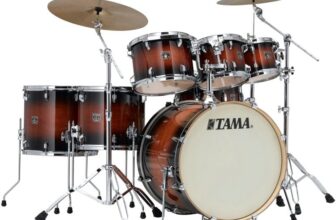If you’ve ever wondered, “How do electronic drums work,” you’re not alone. I’ve been in your shoes, mystified by the technology and eager to understand.
By reading this article, you’ll understand electronic drums comprehensively, from their components to their usage, enhancing your musical experience.
In short, electronic drums use sensors on drum pads to detect hits, which then send signals to a sound module to produce various drum sounds.
Now that we’ve whet your appetite let’s dive in and unravel the fascinating world of electronic drums.

Components of Electronic Drums
Navigating the landscape of electronic drums can seem daunting at first, but let’s break it down into its main components – the pads, sensors, and sound modules.
Pads
Consider the pads as the canvas on which you paint your rhythm. They take the place of the traditional drum skin and come in different types.
Rubber Pads
Rubber pads, the earliest and most common type, are like the reliable old friend you can always count on. They’re durable and offer a consistent feel, much like an old-school practice pad.
Mesh Pads
Then there are mesh pads, the excellent newcomer on the block. These pads feature a tightly woven fabric surface, and their tension can be adjusted, much like tuning a traditional drum. They offer a more authentic drumming experience, responding to the subtle nuances of your playing.
But what happens when you strike these pads? Well, that’s where the magic, or rather, science, begins.
Sensors
Sensors are like the secret agents of electronic drums. They lie in wait under the pads, ready to spring into action the moment you strike a beat.
Piezoelectric Sensors
Piezoelectric sensors, for instance, are like skilled codebreakers. They translate the physical impact of your drumstick into an electrical signal. Think of it as Morse code for drums – every hit sends a unique message.
Force Sensing Resistors
Then there are Force Sensing Resistors or FSRs. These clever devices measure the pressure you apply to the pad. It’s like having a personal trainer, gauging your strength, and adjusting the output accordingly.
And where do these coded messages and pressure readings go? That’s right – to the brains of the operation, the sound module.
Sound Modules
The sound module is the orchestra conductor of your electronic drum kit, interpreting your beats and producing the corresponding sounds.
Role of the Sound Module
Think of the sound module as a vast library of sounds, each cataloged and ready to be summoned immediately. When it receives a signal from a sensor, it flips through its catalog, finds the matching sound, and projects it out loud for all to hear.
Pre-recorded Samples
But these sounds aren’t just plucked from thin air. They come from high-quality recordings of actual drums, also known as samples.
Imagine having a team of professional drummers, each ready to play their part at your command. That’s the power of pre-recorded samples in electronic drums.
And there you have it – the anatomy of electronic drums. From the tactile pads that capture your rhythm through the intelligent sensors that translate your beats to the versatile sound module that orchestrates the final output, it’s a journey of art meeting science.
Now, let’s dive deeper into the fascinating science behind these ingenious instruments.

The Science Behind Electronic Drums
Let’s explore the impressive technological wonders that make electronic drums possible.
What is MIDI?
MIDI, standing for Musical Instrument Digital Interface, is essentially the courier service for your drum beats. It relays the specifics of your drumstick strikes to the sound module, much like a dedicated postal service for your musical notes.
The Role of Digital Signal Processing (DSP)
Think of DSP, or Digital Signal Processing, as the maestro of the sound module. It deciphers the ‘musical messages’ transmitted via MIDI, turning them into tangible sounds.
Imagine DSP as a master chef, converting raw ingredients (MIDI data) into a mouth-watering dish (the drum sound).
Understanding Velocity Sensing
Velocity sensing is like the ‘seismograph’ of your electronic drum set. It gauges how hard you’ve hit a drum pad, ensuring that the sound module ‘feels’ the intensity of your playing.
For instance, if you lightly tap the pad, it’s like a whisper, and the resulting sound will be soft. On the other hand, a forceful strike is equivalent to shouting, and the produced sound will be much louder.
The Importance of Dynamic Response
The dynamic response is the way the sound module adapts to your playing intensity. Much like adding spices to a dish for flavor, it modifies the drum sound based on your playing strength.
For example, a gentle tap on the drum pad can produce a soft, mellow sound, much like a light sprinkle of salt on a dish. Conversely, a powerful strike can result in a loud, booming sound, akin to a generous dash of spicy pepper.

Using Electronic Drums
The exciting world of electronic drums doesn’t end with understanding the technology behind them. Now, let’s step into the practical side of things and look at how you can truly bring an electronic drum kit to life.
Amplification and Headphones
Imagine you’ve just set up your brand-new electronic drum kit. You sit down, sticks in hand, ready to rock out, but then you realize: “Do electronic drums need an amp?”
The answer is not always. Just like a kid with a new toy on Christmas morning who can’t play because he forgot the batteries, you don’t want to be caught without a way to hear your drums.
Electronic drums, unlike their acoustic counterparts, don’t produce sound on their own.
Think of them like a radio that needs speakers. The drum pads send signals to the sound module, which then produces the sounds, but you need a medium to actually hear these sounds. This can be an amplifier or headphones.
Now, picture yourself playing the drums late at night. You’re in the zone, but then you remember your grumpy neighbors or sleeping family members.
This is where headphones come in handy. You can connect headphones directly to most electronic drum kits and keep your jam session confined to your ears only.
Using headphones with electronic drums isn’t just about keeping the peace, though. It’s like having a private concert in your head, where every little nuance and detail of your playing is brought to the forefront.
However, it’s worth noting that while headphones provide a more intimate listening experience, an amplifier can give you a sense of power and space that headphones can’t match. Think of it as the difference between watching a movie on your phone versus in a movie theater.
Professional Use of Electronic Drums
Now, let’s shift gears a bit. You might wonder, “Do professional drummers use electronic drums?” The answer is a resounding yes.
Electronic drums have made their way onto stages worldwide and into the hands of some of the biggest names in music.
Imagine you’re a drummer in a band that plays a wide variety of music. One minute, you’re playing a rock song that requires a powerful drum sound, and the next minute you’re playing a jazz song that needs a softer, more subtle sound.
With an acoustic drum set, you’d need to switch between different drums and cymbals. But with electronic drums, you can switch between entirely different drum kits with just the press of a button.
Consider the case of Danny Carey, the drummer for the band Tool. Carey uses electronic drums to expand his sonic palette and create sounds that would be impossible with an acoustic drum set.
Imagine being able to conjure the sound of a massive gong or a delicate bell with just a tap on a drum pad. That’s the power of electronic drums in the hands of a professional.

Advantages and Disadvantages of Electronic Drums
In the world of drumming, the rise of electronic drums is akin to the advent of electric cars in the automotive industry. Electric vehicles have unique benefits and limitations, and so do electronic drums. Let’s delve into this in more detail.
Advantages of Electronic Drums
Imagine you’re living in a small apartment with paper-thin walls. You’re passionate about drumming, but the noise of acoustic drums would make you an instant nuisance. This is where electronic drums shine like a drummer’s knight in digital armor.
- Quiet Practice: The number one advantage of electronic drums is the ability to practice quietly. Plug in your headphones, and you’re in your own world of rhythms without disturbing a soul. It’s like reading a book in a library; you’re fully immersed, but no one else knows.
- The versatility of Sounds: Your sound palette is virtually limitless with electronic drums. Think of it like being a painter who isn’t restricted to primary colors. You can mix, match, and create any sound, from snare drums to xylophones to cymbals from a 1970s rock kit.
- Compact and Portable: Electronic drum sets are compact and portable, much like a laptop compared to a desktop computer. They only take up a little space, and you can pack them up for gigs or practices much more conveniently than traditional drums.
Disadvantages of Electronic Drums
However, electronic drums have their drawbacks. Let’s say you’re a die-hard fan of vintage cars. You appreciate their charm, the roar of their engines, and the feel of the road underneath. Similarly, many drummers value acoustic drums’ authentic feel and organic sound.
- Lack of “Real” Feel: Electronic drums don’t offer the same tactile response as acoustic drums. It’s akin to typing on a touch screen vs. a mechanical keyboard; the former is smoother, but the latter gives satisfying tactile feedback.
- Sound Limitations: Despite the wide range of sounds, some argue that electronic drums can only partially replicate the nuances of an acoustic drum sound. It’s like comparing a photograph of a rose to the real thing – the photo might be beautiful, but it lacks the depth and fragrance of the real flower.
- Price: High-quality electronic drum sets can be more expensive than entry-level acoustic sets. It’s like choosing between a high-end smartphone and a basic old-school mobile; the former offers more features but has a heftier price tag.
Conclusion
We’ve unraveled the intricacies of how do electronic drums work, from their technological components to their versatile application.
Key factors in choosing electronic drums include price, quality, functionality, and individual needs. The most expensive set isn’t always the best for you.
Think of electronic drums as your sound palette, ready to shape your unique musical expression. Each journey begins with one beat.
So, why wait? Let your journey in understanding how electronic drums work be your starting beat. Start your drumming saga today, and shape melodies that speak to your soul.
My name is Denis. I am a drummer, percussionist, music enthusiast, and blogger. Drums have been my passion for 15 years now. My idea is to write about the things I like and I am interested in. I want to share my drum passion with fellow musicians who walk, talk, and breathe drums.






